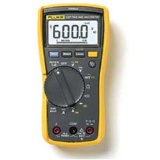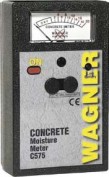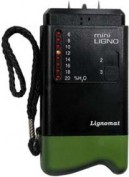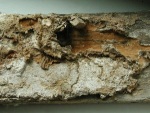

Search This Site
Search With Google
Stucco Moisture
4-
5-
Present Day Issues With Stucco
Without a doubt, stucco is a very good cladding system. One cannot dispute that and besides it wouldnt be used if it was not any good. Stucco systems are very efficient, well designed and suitable for the majority of homes. One downside to the stucco system is that it does rely upon the installation details which are completely concealed once the application of the system has been done. Hence the most important part of the system is the flashing and moisture barrier. If the installation job is not done well or properly then the homeowner will have severe problems from water intrusion damage. It is not possible to know if the installation has been done properly until it is too late. This is because many issues are concealed behind the stucco and not discovered until a professional test has taken place. Problems behind stucco usually require large wall surfaces of stucco to be removed and replaced. This can be costly and very time consuming.
Is moisture building up in the walls?
To know what is happening behind stucco a full professional moisture inspection is required. There are many ways and methods of doing this with an array of tools. You can test areas with a moisture meter but the much preferred method is to use an intrusive probe connected with a moisture meter to test the materials behind the stucco.
A scanner or infrared camera can also be used in the quest for moisture content levels, but they cannot be used on their own. This is because any wet areas located must be probed to check for rot amd mold and of the course, the actual moisture level content. With an infrared camera as well, it will not be able to detect damaged areas in the same way as probing does. Probing will allow you to ascertain the firmness of an area. Probing is by far the best method for testing stucco for moisture content issues.
A pin moisture meter is our preferred method. You can insert the pins into the stucco and gain a reading. Once the moisture meter probes have been removed, the remaining holes can be filled in with a caulk.
Repairing Stucco
The management of moisture is the trick to keeping your stucco in tip top condition. Damage can take place in older buildings or in badly installed stucco. Water damage can result in rust and rot. Stucco is breathable and will allow moisture vapour to pass through it. This means it can dry out. Repairing stucco can be done and is a pretty much straightforward process that will leave the surfaces back in good condition.
You can paint your stucco in any colour you desire with portland cement based paints. The paint needs to be scrubbed in to the surface of the stucco and fully cured. You can use other types of paint but they will not last as long as a cement based paint.
Cleaning stucco can be done easily providing there is no biological growth, contamination or staining with it. Most dirt can be easily removed. Water temperatures, strength of scrubbing and chemical detergents can all be changed for different types of dirt.
Moisture Meter Guide
The complete moisture meter website
Stucco is the name given to a type of plaster material that is applied to the outside of buildings and wooden structures. It is made up from aggregate materials, a binder and water. Stucco is applied to masonrt or wood when wet and after it has dried, it forms a very solid and dense protective coat for you building whilst looking attractive as well. Stucco proves to be a relatively low maintenance exterior finish for your home.
Stucco proves itself to be a good cladding system providing that any construction defects are repaired before application and the system is well maintained. As of today there is no such thing as a maintenance free cladding system for you home. Leaks can occur in all types of cladding systems but it must be noted that any leaks with the stucco system must be maintained immediately because of the destructive nature of water intrusion. With your stucco cladding system this is critical. Your first line of defence against water intrusion are the sealant joints. In many cases theses sealant joints are your only defence against water intrusion. Any water intrusion can result in your synthetic stucco system breaking down and the appearance of your home downgrading rapidly. But with proper care and maintenance of your stucco system you will get many years of good function from it and your home looking very nice with it.
To protect your home stucco system there are several steps to be taken;
1-
2-
3-
Moisture Meter Guide 2010 Contact details:garnett65@hotmail.com
Moisture Meter Brands On This Site













Wagner Moisture Meters
General Tools MMD5NP Pinless LCD
General Tools MMD7003 Precision
General Tools MMD8P Multi Species
Condensation
This is damp from the air. Basically it is warm air which contains water vapour being cooled. This can happen from coming in to contact with a colder surface. Condensation facts
Rising Damp
Rising damp is caused by ground moisture rising up in to floors and walls of your home. This moisture will continue rising up on its journey until it evaporates. Rising damp information
Wet Rot
Despite the fact that wet rot is not as hard to eradicate as dry rot, it does occur more in buildings than dry rot. Wet rot can cause you severe problems and damage in your home. Wet rot pointers
Dry Rot
Unfortunately dry rot is one of the most damaging conditions you can have in your building. In order for dry rot to flourish it requires moisture. This moisture can come from many different sources in the home. Dry rot facts


Building Mold
Basically moulds are fungi which are a common group or organisms that also include yeasts and mushrooms. Moulds are usually found out in nature but can be carried to the indoors from the outdoors. To date more than 270 species of mould have been found and identified in people’s homes. The usual places molds are found in the home are in damp areas where moisture has affected the area. Such instances include in wallpaper, tiles, carpets, wood and insulation materials. This is why it is important to always be aware of moisture in the home and carry out spot checks once in a while with a building moisture meter. Building mold

Damp From Floors And Walls Drying Out
Basically caused by moisture content within the structure of your home working itself out from the structure. This type of damp can take months and even years to dry fully. This is because hot air dryers will only dry the moisture content close up to the surface of a material. Floor damp
Penetrating Damp
Penetrating damp is where damp from the rain or damp from the ground enters the walls of your home. It is basically caused by the moisture that enters your home does not have an escape route to follow. Penetrating damp problems
Chemical Damp
Chemical damp is basically caused from salt contamination. When plaster is contaminated by hygroscopic salts these salts will absorb moisture from the air. Chemical damp causes
Damp From Plumbing Leaks
These damps are caused by corrosion of the plumbing and plumbing joints in your home. The pipes can corrode internally over time because the pipes are made using different types of metal. Damp from leaks
| Tramex Moisture Encounter Plus |
| Tramex Compact Wood Moisture Meter |
| Tramex Concrete Encounter Moisture Meter |
| Tramex Skipper Plus Moisture Meter |
| Tramex Roof And Wall Moisture Scanner |
| Sonin Digital Moisture Meter model 50218 |
| Sonin Digital Moisture Meter 270 model 50270 |
| Sonin Moisture Test Tool model 50210 |
| Sonin Moisture Test Meter Model 50211 |
| Oak |
| Douglas Fir |
| Beech Tree |
| Elm Tree |
| Hickory Tree |
| Maple Tree |
| Pine Tree |
| Prevent And Repair Gaps In Wooden Floorboards |
| How To Fix A Squeaky Hardwood Floor |
| How To Repair A Hardwood Floor That Has Buckled |
| Which Is The Best Firewood? |
| Concrete |
| Concrete Moisture |
| Screed Moisture Meter |
| SDS Drill |
| Belle Cement Mixer |
| SDS Drill Advice |
| Which SDS Drill |
| SDS Drill Accessories |
| Drilling Into Concrete |
| Kennedy Tool Box |
| Moisture - Basic Facts |
| Types Of Damp |
| Wet Rot |
| Dry Rot |
| Mold |
| Water Leak Detection |
| Stucco Moisture |
| Water Damage |
| Moisture And Rust |
| Moisture Damage To A Chimney |
| Wallpaper Stripper |
| Plaster Mixer |
| Why Worry About Moisture Problems |
| Does Your Home Have A Moisture Problem? |
| How To Solve Moisture Problems |
| How To Use Anti Mold Paint |
| Rising Damp |
| Condensation |
| Salt Damp |
| How To Avoid Bathroom Condensation |
| How To Remove Black Mold |
| How To Prevent Bathroom Mold |
| Soldering Kit |
| Soldering Kit Contents |
| Soldering Kit Advice |
| Bonsai Tree Classification |
| Growing Bonsai From Seed |
| Bonsai Tree Care |
| Bonsai Tree Training |
| Bonsai Tools |
| Displaying Bonsai |
| Bonsai Calendar |
| Bonsai Plants |
| The Thirsty Light Curve Moisture Meter |
| The Thirsty Light Ladybird Moisture Meter |
| The Thirsty Light Bumble Bee Moisture Meter |
| The Thirsty Light Butterfly Moisture Meter |
| Hanna Instruments |
| Agratronix Portable Coffee Moisture Tester |
| Lawn Aerator |
| Lawn Roller |
| Lawn Rake |
| Lawn Sand |
| Chainshot |
| Chainsaw Gloves |
| Chainsaw Trousers |
| Chainsaw Boots |
| Mac 4 - 20 XT Chainsaw |
| Mac 738 Chainsaw |
| Mac 842 Chainsaw |
| Mac 20X Power Chainsaw |
| Einhell BG-PC 3735 Chainsaw |
| Einhell BG-PC 4040 Chainsaw |
| Einhell BG-PC 5045 Chainsaw |
| Poulan P3314 Chainsaw |
| Poulan P4018 Chainsaw |
| Poulan Pro PP3816AV Chainsaw |
| Poulan Pro PP4218AVX Chainsaw |
| Poulan Pro PP4620AVX Chainsaw |
| Efco MT 4100 SP Chainsaw |
| Efco MT 3500 Chainsaw |
| Efco 132 S Chainsaw |
| Efco 147 Chainsaw |
| Efco 152 Chainsaw |
| Efco MT 7200 Chainsaw |
| Efco MT 8200 Chainsaw |
| Efco MT 3750 Chainsaw |
| Methods Of Obtaining Soil Moisture Levels |
| Hygrometer |
| Psychrometer |
| Rain Gauge |
| Wave Ventilation System |
| Humidity |
| Hygrometer For Keeping Reptiles |
| Humidor |
| Weather Stations |
| Musical Instrument Storage |